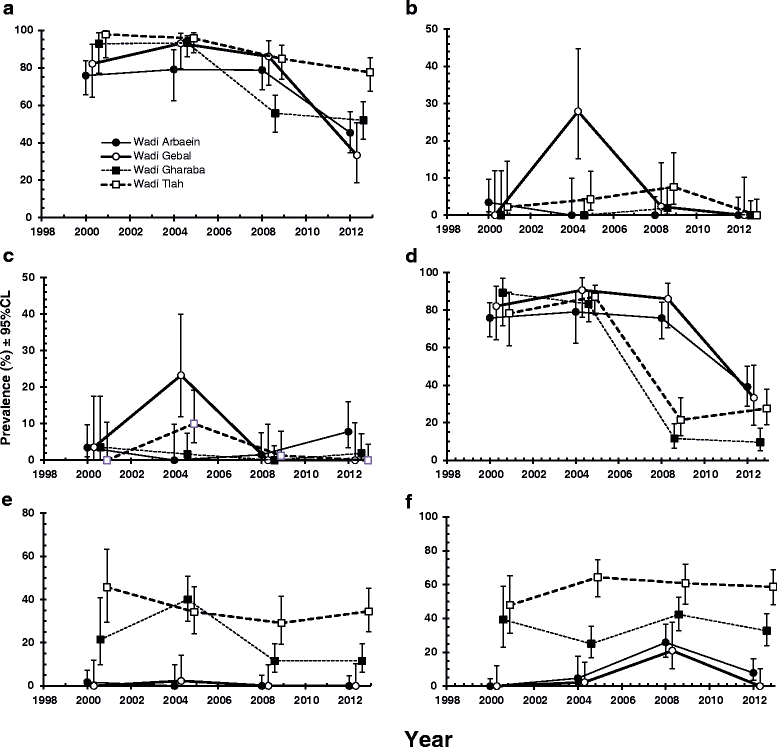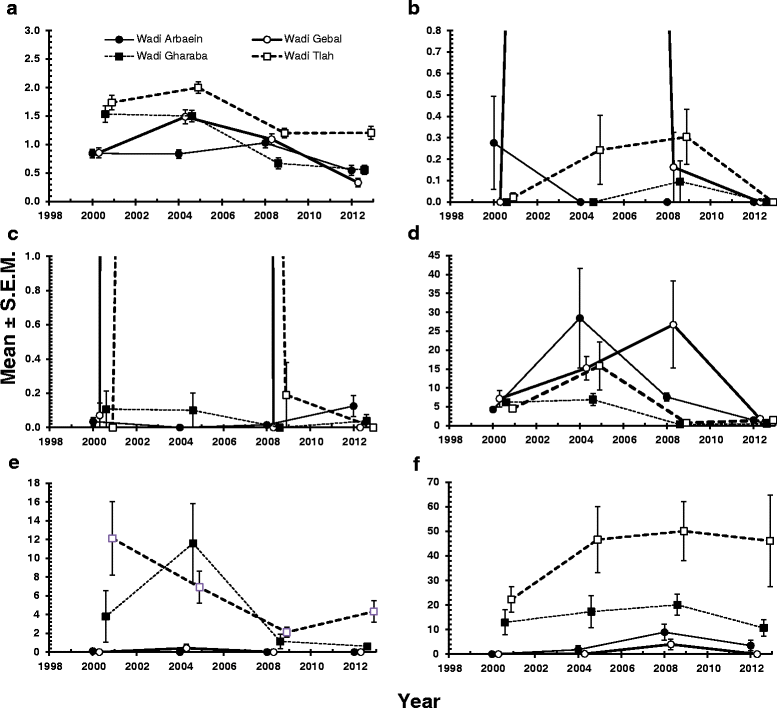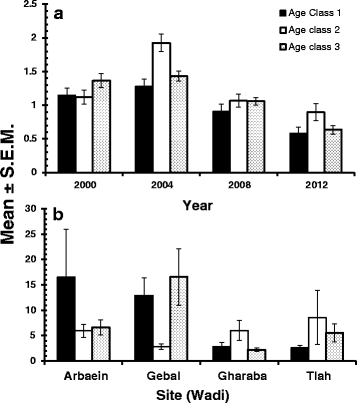Long-term spatiotemporal stability and dynamic changes in the haemoparasite community of spiny mice (Acomys dimidiatus) in four montane wadis in the St. Katherine Protectorate, Sinai, Egypt
- PMID: 27059180
- PMCID: PMC4826546
- DOI: 10.1186/s13071-016-1471-z
Long-term spatiotemporal stability and dynamic changes in the haemoparasite community of spiny mice (Acomys dimidiatus) in four montane wadis in the St. Katherine Protectorate, Sinai, Egypt
Abstract
Background: Long-term field studies of parasite communities are rare but provide a powerful insight into the ecological processes shaping host-parasite interactions. The aim of our study was to monitor long-term trends in the haemoparasite communities of spiny mice (Acomys dimidiatus) and to identify the principal factors responsible for changes over a 12 year period.
Methods: To this end we sampled four semi-isolated populations of mice (n = 835) in 2000, 2004, 2008 and 2012 in four dry montane valleys (wadis) located in the Sinai Massif, Egypt.
Results: Overall 76.2 % of spiny mice carried at least one of the five haemoparasite genera (Babesia, Bartonella, Haemobartonella, Hepatozoon, Trypanosoma) recorded in the study. Prevalence of haemoparasites varied significantly between the sites with the highest overall prevalence in Wadi Tlah and the lowest in W. El Arbaein, and this changed significantly with time. In the first two surveys there was little change in prevalence, but by 2008, when the first signs of a deepening drought in the region had become apparent, prevalence began to drift downwards, and by 2012 prevalence had fallen to the lowest values recorded from all four sites over the entire 12-year period. The overall mean species richness was 1.2 ± 0.03, which peaked in 2004 and then dropped by more than 50 % by 2012. Species richness was highest among mice from Wadi Tlah and peaked in age class 2 mice (young adults). Site was the most significant factor affecting the prevalence of individual parasite species, with Trypanosoma acomys and Hepatozoon sp. occurring mainly in two wadis (W. Tlah & W. Gharaba). In four of the five genera recorded in the study we observed a significant drop in prevalence or/and abundance since 2004, the exception being Hepatozoon sp.
Conclusions: During the 12-year-long period of study in the Sinai, we observed dynamic changes and possibly even cycles of prevalence and abundance of infections which differed depending on parasite species. Although the exact reasons cannot be identified at this time, we hypothesize that the effects of a 15-year-long scarcity of rainfall in the local environment and a fall in host densities over the period of study may have been responsible for a drop in transmission rates, possibly by a negative impact on vector survival.
Keywords: Abundance; Acomys dimidiatus; Acomys russatus, haemoparasites; Babesia; Bartonella; Between year variation; Drought; Haemobartonella; Hepatozoon; Prevalence; Sinai; Species-richness; Trypanosoma.
Figures






Similar articles
-
Variation in the helminth community structure in spiny mice (Acomys dimidiatus) from four montane wadis in the St Katherine region of the Sinai Peninsula in Egypt.Parasitology. 2004 Sep;129(Pt 3):379-98. doi: 10.1017/s003118200400558x. Parasitology. 2004. PMID: 15471013
-
Gastrointestinal nematode community of spiny mice (Acomys dimidiatus) from St. Katherine, South Sinai, Egypt.J Parasit Dis. 2015 Dec;39(4):705-11. doi: 10.1007/s12639-013-0410-6. Epub 2013 Dec 10. J Parasit Dis. 2015. PMID: 26688638 Free PMC article.
-
Long-term spatiotemporal stability and dynamic changes in helminth infracommunities of spiny mice (Acomys dimidiatus) in St. Katherine's Protectorate, Sinai, Egypt.Parasitology. 2019 Jan;146(1):50-73. doi: 10.1017/S0031182018000987. Epub 2018 Jun 20. Parasitology. 2019. PMID: 29921333
-
Long-term spatiotemporal stability and dynamic changes in the haemoparasite community of bank voles (Myodes glareolus) in NE Poland.Microb Ecol. 2014 Aug;68(2):196-211. doi: 10.1007/s00248-014-0390-9. Epub 2014 Mar 7. Microb Ecol. 2014. PMID: 24604428 Free PMC article.
-
Intestinal helminths of spiny mice (Acomys cahirinus dimidiatus) from St Katherine's Protectorate in the Sinai, Egypt.J Helminthol. 2000 Mar;74(1):31-43. J Helminthol. 2000. PMID: 10831051
Cited by
-
Candidatus Neoehrlichia mikurensis and Hepatozoon sp. in voles (Microtus spp.): occurrence and evidence for vertical transmission.Sci Rep. 2023 Jan 31;13(1):1733. doi: 10.1038/s41598-023-28346-0. Sci Rep. 2023. PMID: 36720952 Free PMC article.
-
Genetic and phylogenetic analysis of the ticks from the Sinai Massif, Egypt, and their possible role in the transmission of Babesia behnkei.Exp Appl Acarol. 2017 Aug;72(4):415-427. doi: 10.1007/s10493-017-0164-4. Epub 2017 Aug 28. Exp Appl Acarol. 2017. PMID: 28849399 Free PMC article.
-
The first report on Hepatozoon canis in dogs and wolves in Poland: clinical and epidemiological features.Parasit Vectors. 2023 Sep 4;16(1):313. doi: 10.1186/s13071-023-05928-5. Parasit Vectors. 2023. PMID: 37667369 Free PMC article.
-
Genetic diversity of Bartonella spp. in rodents and fleas from Poland.Sci Rep. 2025 Mar 28;15(1):10710. doi: 10.1038/s41598-025-92127-0. Sci Rep. 2025. PMID: 40155452 Free PMC article.
-
Tick-borne diseases in Egypt: A one health perspective.One Health. 2022 Oct 10;15:100443. doi: 10.1016/j.onehlt.2022.100443. eCollection 2022 Dec. One Health. 2022. PMID: 36561707 Free PMC article. Review.
References
-
- Bujalska G, Hansson L. Bank vole biology: recent advances in the population biology of a model species. Pol J Ecol. 2000;48:5–7.
-
- Flowerdew JR, Gurnell J, Gipps JHW. The ecology of woodland rodents: bank voles and wood mice: the proceedings of a symposium held at the Zoological Society of London on 23rd and 24th of November 1984. 1985.
Publication types
MeSH terms
LinkOut - more resources
Full Text Sources
Other Literature Sources
Medical

